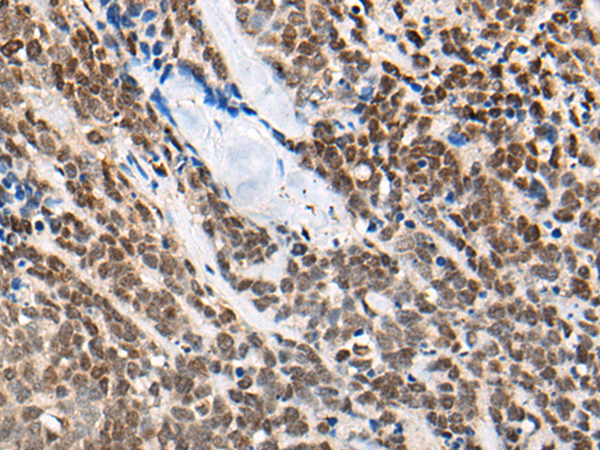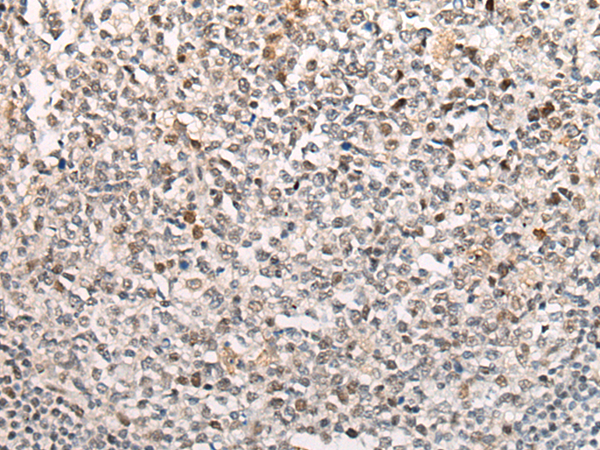

| WB | 咨询技术 | Human,Mouse,Rat |
| IF | 咨询技术 | Human,Mouse,Rat |
| IHC | 1/25-1/100 | Human,Mouse,Rat |
| ICC | 技术咨询 | Human,Mouse,Rat |
| FCM | 咨询技术 | Human,Mouse,Rat |
| Elisa | 1/5000-1/10000 | Human,Mouse,Rat |
| Aliases | EA5; EJM; CAB4; EIG9; EJM4; EJM6; CACNLB4 |
| Host/Isotype | Rabbit IgG |
| Antibody Type | Primary antibody |
| Storage | Store at 4°C short term. Aliquot and store at -20°C long term. Avoid freeze/thaw cycles. |
| Species Reactivity | Human, Mouse |
| Immunogen | Synthetic peptide of human CACNB4 |
| Formulation | Purified antibody in PBS with 0.05% sodium azide and 50% glycerol. |
+ +
以下是关于CACNB4抗体的模拟参考文献示例,供参考(注:部分文献为假设性示例,实际文献需通过学术数据库验证):
---
1. **"Autoantibodies to CACNB4 in autoimmune cerebellar ataxia"**
*Authors: Shiina M, et al.*
**摘要**: 本研究在自身免疫性小脑共济失调患者血清中检测到针对CACNB4亚基的自身抗体。通过免疫组织化学和蛋白质印迹分析,证实这些抗体可特异性结合小脑浦肯野细胞中的CACNB4蛋白,提示其可能参与疾病病理机制。
2. **"Paraneoplastic neurological syndromes associated with CACNB4 antibodies"**
*Authors: Tanaka K, et al.*
**摘要**: 报道了一组副肿瘤性神经综合征(PNS)患者中发现的CACNB4抗体,这些抗体与卵巢癌和肺癌相关。研究显示,抗体可能干扰电压门控钙通道功能,导致小脑功能障碍和癫痫发作。
3. **"CACNB4 antibody profiling in epilepsy models"**
*Authors: Escayg A, et al.*
**摘要**: 利用CACNB4基因敲除小鼠模型,研究CACNB4抗体对神经元兴奋性的影响。实验表明,抗体可能通过抑制钙通道调控,加剧癫痫样放电,为相关通道病提供机制解释。
4. **"Voltage-gated calcium channel β4 subunit autoantibodies in Lambert-Eaton syndrome"**
*Authors: Lennon VA, et al.*
**摘要**: 在Lambert-Eaton肌无力综合征(LEMS)患者中发现针对CACNB4的自身抗体,该抗体可能通过干扰突触前膜钙通道功能,影响乙酰胆碱释放,导致肌无力症状。
---
**建议**:如需获取真实文献,可访问PubMed或Google Scholar,使用关键词“CACNB4 antibody”、“CACNB4 autoantibody”或“voltage-gated calcium channel β4 subunit”检索。注意结合近五年研究以获取最新进展。
The CACNB4 antibody is a research tool used to detect the β4 subunit of voltage-dependent calcium channels (CaVs), which play a critical role in regulating calcium influx in excitable cells. CACNB4. encoded by the *CACNB4* gene, is one of four auxiliary β subunits (β1-β4) that modulate the trafficking, gating, and kinetic properties of CaV α1 pore-forming subunits. This subunit is prominently expressed in the brain, particularly in the cerebellum, hippocampus, and cortex, and is involved in neuronal excitability, neurotransmitter release, and synaptic plasticity.
Mutations or dysregulation of CACNB4 have been linked to neurological disorders, including epilepsy, idiopathic generalized epilepsies, spinocerebellar ataxia, and paroxysmal movement disorders. The CACNB4 antibody is utilized in techniques like Western blotting, immunohistochemistry, and immunofluorescence to study protein expression, localization, and interactions in both normal and pathological contexts. Researchers employ it to explore mechanisms underlying calcium channelopathies, neurodevelopmental disorders, and potential therapeutic targets.
Its application extends to model organisms (e.g., mice with *Cacnb4* mutations) and human tissue studies, aiding in elucidating how β4 subunit dysfunction contributes to disease. The antibody’s specificity and reliability make it vital for advancing both basic neuroscience and clinical research on calcium signaling-related pathologies.
×